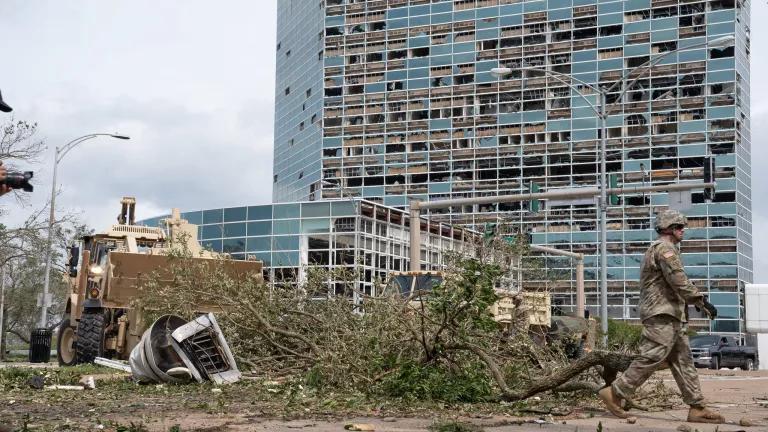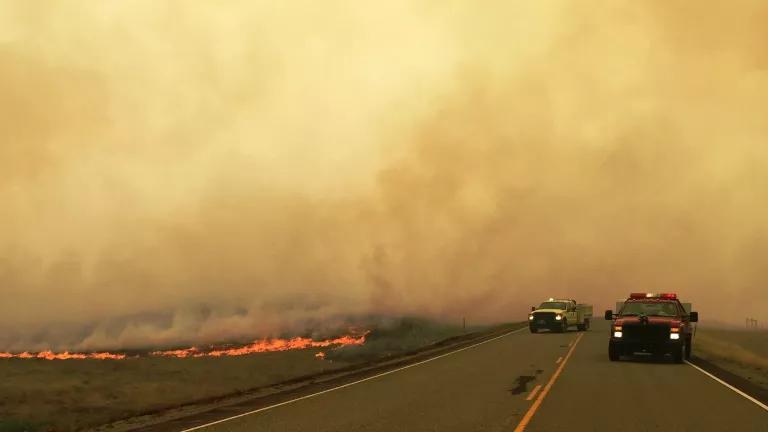Investments in International Climate Action in President Obama's Budget Request for FY2017
President Obama's budget request for the 2017 fiscal year continues to make critical investments in international climate action. This includes funding for smart investments to adapt to the impacts of climate change, and to support developing countries in developing low emissions economies. It also includes $750 million in new funding for the Green Climate Fund. The total budget request in support of international action on climate change is $1.3 billion. These funds not only address immediate needs for adapting to climate change, but encourage the transition to a clean energy economy.
A variety of programs within the President's Global Climate Change Initiative and other initiatives will support climate action by the State Department, Treasury, and others. The initiatives include adaptation measures to address climate change, clean energy deployment, sustainable land use and other support for developing countries. The investments help to reduce greenhouse gas emissions around the world and helping build resilience among populations vulnerable to the impacts of climate change.
Here are key items for international climate action in the new budget:
- Green Climate Fund contribution: The $750 million requested for the Green Climate Fund will help developing countries leverage public and private financing to reduce carbon pollution and strengthen resilience to climate change. (The US pledge for the GCF is $3 billion over four years. Last year, the budget for FY 2016 included an initial contribution of $500 million for the GCF.) The GCF helps developing countries leverage public and private finance to invest in reducing carbon pollution and strengthening resilience to climate change. It builds on the best practices and lessons learned from the Climate Investment Funds (CIFs) - a fund to which the United States contributed starting in President George W. Bush's term.
- Bilateral cooperation: Funds will also support programs for bilateral cooperation with developing nations on clean energy and emissions reductions through activities such as the Clean Energy Ministerial, the Climate and Clean Air Coalition, and the U.S.-Africa Clean Energy Finance initiative. It also includes national level funding for countries such as Peru and Nepal to deal with the worst potential impacts from climate change through programs operated by the U.S. Agency for International Development (USAID).
- Multilateral cooperation: Other funding includes a contribution of $32.5 million to the Montreal Protocol to support countries in phasing down ozone depleting gases that are also potent global warming pollutants; the US contribution towards the Intergovernmental Panel on Climate Change and UN Framework Convention on Climate Change for $13 million; and continued support to the Global Environment Facility (GEF). Part of the GEF funding will support the efforts of countries to implement their climate action plans that were submitted to the UNFCCC for the Paris climate conference. This will help countries reduce their emissions, improve their action plans, boost resilience, adaptation, and the transparency of the reporting and implementation of the action plans in many countries. Additional funding includes $12.5 million for the Central American and Caribbean Catastrophic Risk Insurance Facility (CCRIF). This is the first request the US Treasury has made for CCRIF. The contribution helps Central America and the Dominican Republic purchase risk insurance and provides technical assistance to manage potentially catastrophic disaster risks.
- Supporting National Adaptation Plans: $142 million will help least-developed countries, glacier-dependent nations, small-island developing nations, and other countries most prone to climate-related disasters develop National Adaptation Plans. These investments will help communities cope with the adverse impacts of climate change.
- Clean energy programs: $93 million will help reduce long-term emissions trends. Clean energy assistance programs allow countries to build fledgling energy systems with emphasis on renewable energy and energy efficiency rather than highly-polluting energy sources. The programs help improve electricity grids, provide clean energy finance, and tackle emissions reductions across various sectors. These programs also help developing countries develop energy components of their Low Emission Development Strategies in Asia, Latin America, Europe and Eurasia, and countries participating in the Power Africa Initiative.
- Sustainable landscapes program: part of the $76 million requested for 2017 will help countries tackle deforestation and land degradation, drivers of greenhouse gas emissions. This includes cooperation with the Tropical Forest Alliance 2020, and action under the Low Emissions Development Strategies to measure and reduce emissions from land use.
- U.S. Global Development Lab: As part of the Mission Innovation commitment by the U.S. and 19 other countries to increase research and development for global clean energy, the Lab will support clean energy R&D efforts with partner nations for projects such as electric vehicles, and efficient buildings.
- Feed the Future initiative: Part of this initiative will implement the President's Executive Order on Climate-Resilient International Development. This will boost resilience in agriculture to climate change and extreme weather - reducing food insecurity and boosting agricultural yields and household income and helping transition farmers to resilient agricultural systems. The work can also help reduce greenhouse gas emissions from agricultural activities.
These investments are in America's interest.
Addressing climate change through proactive investments is better for America's bottom line. Investments in a global clean energy transformation will create new markets for American businesses leading in clean energy and energy efficiency. The investments in the Clean Energy Ministerial, Global Development Lab, clean energy programs, and Green Climate Fund are paving the way for future investments in areas such as wind, solar, energy efficiency, and geothermal around the world. American companies are already tapping into the growing clean energy market and more are poised to join.
Support for adaptation through assistance with National Adaptation Plans, Global Environmental Facility, Green Climate Fund, and other initiatives increases the resilience of the most vulnerable countries to the impacts of climate change, avoiding potentially devastating and costly impacts later on. Countries around the world are already feeling the impacts from extreme weather events. Investing in efforts to strengthen countries' resilience to climate risks will reduce future costs from inaction.
Future climate change impacts are projected to reduce agricultural productivity, threaten water supplies, wreak havoc on infrastructure, and increase public health risks. Investing in climate action not only reduces these risks, it opens up new economic opportunities as the clean energy revolution accelerates. American can provide leadership for a global low-carbon transformation. For that reason, Congress would be wise to support these climate investments and initiatives that will reap dividends in the long run.



